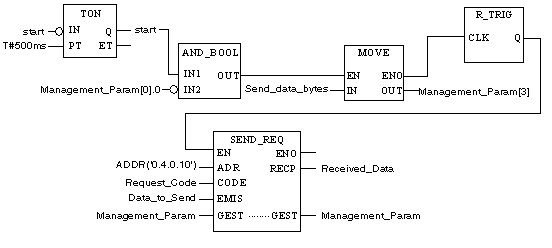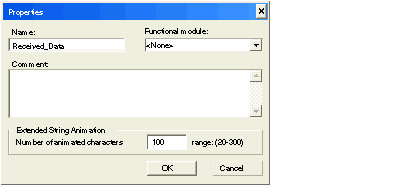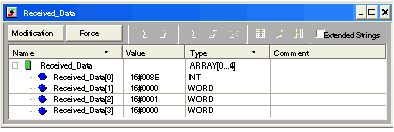|
SEND_REQ Example - Get_Attributes_Single
|
|
|
Original instructions
|

|
Input pin
|
Variable
|
Data type
|
|---|---|---|
|
IN
|
start
|
BOOL
|
|
IN
|
Send_data_bytes
|
INT
|
|
CODE
|
Request_Code
|
INT
|
|
EMIS
|
Data_to_Send
|
Array [0...4] of 5 INT
|
|
Input pin
|
Variable
|
Data type
|
|---|---|---|
|
GEST
|
Management_Param
|
Array [0...3] of 4 INT
|
|
Output pin
|
Variable
|
Data type
|
|---|---|---|
|
RECP
|
Received_Data
|
Array [0...3] of 4 INT
|
|
Variable
|
Description
|
Value (hex)
|
|---|---|---|
|
Request_Code
|
Code identifies a CIP request
|
16#000E
|
|
Variable
|
Description
|
Value (hex)
|
|---|---|---|
|
Data_to_Send[0]
|
Message type:
In this example, unconnected is selected.
|
16#0000
|
|
Data_to_Send[1]
|
High byte = Request path size (03)
Low byte = Service: Get_Attribute_Single (0E)
|
16#030E
|
|
Data_to_Send[2]
|
High byte = Class (01)
Low byte = Class Segment (20)
|
16#0120
|
|
Data_to_Send[3]
|
High byte = Instance (01)
Low byte = Instance Segment (24)
|
16#0124
|
|
Data_to_Send[4]
|
High byte = Attribute (01)
Low byte = Attribute Segment (30)
|
16#0130
|
|
Variable
|
Description
|
Value (hex)
|
|---|---|---|
|
Management_Param[0]
|
High byte = Exchange number (managed by system)
Low byte = Activity bit (managed by system)
|
(read-only)
|
|
Management_Param[1]
|
High byte = Operation report
Low byte = Communication report
|
(read-only)
|
|
Management_Param[2]
|
Timeout in ms—0 indicates infinite
|
16#0000
|
|
Management_Param[3]
|
At input = Length of Data_to_Send variable (in bytes)
At output = Length of Received_Data variable (in bytes)
|
16#000A
|
|
Step
|
Action
|
|
|---|---|---|
|
1
|
In Control Expert, select Tools → Project Browser to open the Project Browser.
|
|
|
2
|
In the Project Browser, select the Animation Tables folder, then click the right mouse button. A pop-up menu appears.
|
|
|
3
|
Select New Animation Table in the pop-up menu. A new animation table and its properties dialog both open.
|
|
|
4
|
In the Properties dialog, edit the following values:
|
|
|
Name
|
Type in a table name. For this example: Received_Data.
|
|
|
Functional module
|
Accept the default <None>.
|
|
|
Comment
|
(Optional) Type your comment here.
|
|
|
Number of animated characters
|
Type in 100, representing the size of the data buffer in words.
|
|
|
5
|
The completed Properties dialog looks like this:
 Click OK to close the dialog.
|
|
|
6
|
In the animation table’s Name column, type in the name of the variable assigned to the databuffer: Received_Data and hit Enter. The animation table displays the Received_Data variable.
|
|
|
7
|
Expand the Received_Data variable to display its word array, where you can view the CIP response at Received_Data(0-4):
 Note: Each array entry presents 2 bytes of data in little endian format, where the least significant byte is stored in the smallest memory address. For example, ‘8E’ in word[0] is the lower byte, and ‘00’ is the upper byte.
|
|